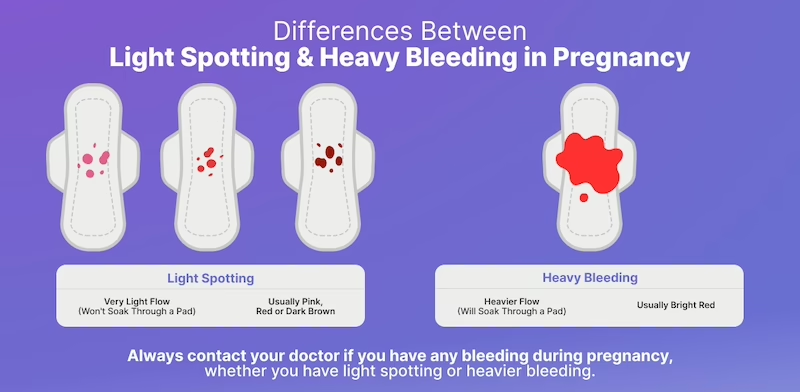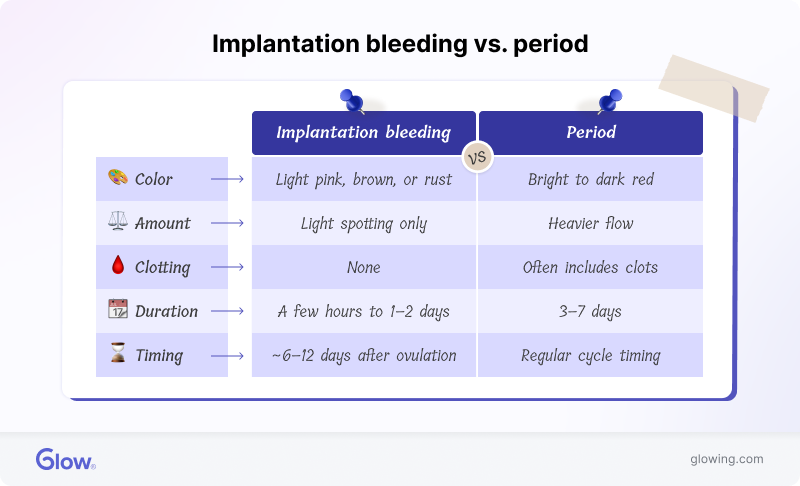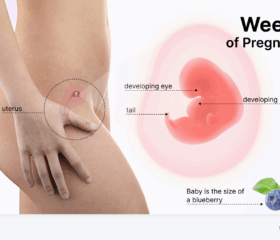Spotting and Bleeding During Pregnancy: What’s Normal?
Seeing any amount of blood during pregnancy can be alarming. However, spotting isn’t always a sign that something’s wrong.

- Is spotting normal during pregnancy?
- What causes spotting in the first trimester of pregnancy?
- When first-timester bleeding can indicate a problem
- What causes spotting and bleeding in the second trimester of pregnancy?
- What causes spotting and bleeding in the third trimester?
- When to speak to your doctor about spotting during pregnancy
- How do you manage spotting during pregnancy?
- Final thoughts
Light spotting is a common experience for many pregnant women. Between 15% and 25% of women notice it during the first trimester, although it can also occur later on in pregnancy. 1
Fortunately, most cases of spotting aren’t serious, but you should always let your doctor know if you experience any bleeding in your pregnancy, just in case.
Read on to learn the difference between spotting and bleeding, the most common causes of spotting throughout pregnancy, and when it can signal a problem.
Is spotting normal during pregnancy?
A little spotting can be totally normal during pregnancy. Most women who experience it don’t have any issues, and go on to have healthy pregnancies and deliveries. 2
However, again, it’s a good idea to let your doctor know if you experience spotting, just to be safe.
What does normal pregnancy spotting look like?
Normal spotting during pregnancy should be light. You’ll usually only see a few drops of pink, red, or dark brown blood on your underwear or on toilet paper after wiping. It shouldn’t be enough to soak through your panty liner.
What’s the difference between spotting and heavy bleeding?
While spotting (just a few drops) isn’t usually a problem during pregnancy, heavy bleeding is another story. It can indicate an issue that needs medical attention.
Heavier bleeding during pregnancy may look similar to your menstrual period. The blood will tend to be bright red, and you’ll need to use a pad or liner to keep it from soaking through your clothes. 1

To reiterate, while some spotting can be relatively normal, always let your doctor know if you experience any bleeding during pregnancy, regardless of whether it’s relatively light or a heavier flow.
What causes spotting in the first trimester of pregnancy?
The first 12 weeks of pregnancy are when you’ll tend to see spotting the most. Most of the time, spotting during the first trimester is the result of normal changes to your body.
Here are a few of the most common causes of spotting during the early weeks of pregnancy:
Implantation bleeding
For many women, implantation bleeding is one of the earliest pregnancy symptoms. It happens when a fertilized embryo attaches itself to the lining of your uterus.
Implantation usually occurs 10 to 14 days after conception (though it can also happen as early as 6 days after the time you’d normally ovulate). Many women mistake it for their period. 3
However, there are a few differences between implantation bleeding and normal menstrual bleeding. Periods tend to be heavier and last longer, and the blood may be a deeper red, with more clotting.

Keep in mind that not all women experience implantation bleeding at all. If you don’t have it, that doesn’t indicate a problem with your pregnancy.
Cervical sensitivity
During pregnancy, your changing hormonal levels can increase blood flow to your cervix, making it softer and more sensitive.
Thanks to this increased sensitivity, you may experience light spotting after activities or in special circumstances such as: 1
- Sexual intercourse: While it’s usually safe to have sex during pregnancy (so long as your doctor doesn’t tell you otherwise), the friction may sometimes irritate your tender cervix.
- Pelvic exams: An internal exam, Pap smear, or vaginal pregnancy ultrasound at your doctor’s office can cause minor spotting.
Other first-trimester causes
Outside of implantation bleeding and a more sensitive cervix, you could also experience spotting in your pregnancy due to: 1
- An infection: A vaginal or cervical infection, such as a yeast infection or bacterial vaginosis, can cause inflammation and lead to light spotting, as well as changes in the color of your pregnancy discharge (i.e., green or yellow discharge). You’ll usually need antibiotics or antifungal medication to treat these infections.
- Cervical polyps: These are harmless growths on the cervix that have more blood vessels during pregnancy, making them more likely to bleed when touched.
- A subchorionic hemorrhage: Also called a subchorionic hematoma, this occurs when blood collects between the uterine wall and the chorionic membrane (part of the sac surrounding the embryo). While it sounds serious, these often resolve on their own without harming the pregnancy, though your doctor will need to keep an eye on you to make sure the bleeding doesn’t get worse.
When first-timester bleeding can indicate a problem
While most causes of spotting during the first trimester are harmless, it can sometimes signal a more serious issue.
In particular, there are two first-trimester complications that often result in spotting or bleeding:
Ectopic pregnancy
An ectopic pregnancy occurs when a fertilized egg implants outside of your uterus, usually in one of your fallopian tubes. Unfortunately, this type of pregnancy is not viable, and your doctor will need to terminate it for your safety.
In addition to light or heavy bleeding, you may experience: 4
- Sharp, stabbing pain in your abdomen, pelvis, or lower back
- Weakness, dizziness, or fainting
- Shoulder pain
- A feeling of pressure on your rectum
Ectopic pregnancies are medical emergencies, so contact your doctor or go to the emergency room right away if you have any of these symptoms.
Miscarriage
Bleeding is one of the most common signs of a miscarriage, which is when you lose your baby before 20 weeks.
Sadly, about 10% of known pregnancies end in miscarriage, usually due to chromosomal abnormalities that are beyond anyone’s control. 5
You may have signs and symptoms like:
- Relatively heavy bleeding, similar to a period
- Passing clots or tissue from the vagina
- Mild to severe cramping or back pain
- A sudden disappearance of pregnancy symptoms like morning sickness or breast tenderness
If you’re bleeding and cramping, get in touch with your doctor right away. They’ll perform tests, like an ultrasound and blood work, to determine what’s happening.
Although it can be difficult to cope after a miscarriage, you’re not alone. There are resources you can look to for support, such as Share Pregnancy & Infant Loss Support, an organization that provides counseling and education for those who’ve experienced miscarriages.
Threatened miscarriage
You may also experience bleeding as a result of a threatened miscarriage, which is when you experience some of the potential signs of a miscarriage (including bleeding) without actually losing your baby.
While this does indicate that you’re at risk of a miscarriage, approximately 50% of women who experience bleeding during pregnancy go on to have healthy pregnancies and give birth successfully. 2
What causes spotting and bleeding in the second trimester of pregnancy?
While it’s less common than in the first trimester, you may still experience spotting in the second trimester.
Usually, this is caused by something fairly harmless like an irritated cervix or a cervical polyp, especially if it occurs after sex or a pelvic exam.
However, you should still let your doctor know immediately if you have any bleeding in the second trimester, as it could indicate an issue like:
- Placenta previa: This condition happens when your placenta grows low in your uterus, causing it to partially or completely cover your cervix. Bright red, painless vaginal bleeding is one of the most common symptoms of placenta previa. You might find that the bleeding stops, then starts again a few days later. 6
- Preterm labor: If you go into labor before week 37 of your pregnancy, it is considered preterm. Bleeding can be a telltale sign of preterm labor, along with other symptoms like regular contractions, pelvic pressure, or a dull backache. You’ll need to let your doctor know immediately if you think you’re going into preterm labor.
- Late miscarriage: While it’s rare, some women experience a type of late miscarriage after 20 weeks. The symptoms of a late miscarriage are similar to those you’ll experience if you lose your baby earlier on, like bleeding and cramping. 7
What causes spotting and bleeding in the third trimester?
Much like in your earlier trimesters, cervical irritation is often the culprit for bleeding during your third trimester.
However, another common cause is experiencing “bloody show.” As your body gears up for labor, the mucus plug that sealed your cervix begins to dislodge. When this happens, you may notice that your pregnancy discharge turns brown as a result of the blood mixing in with your cervical fluid.
This is a normal sign that labor isn’t far off, although it could still be days or even weeks away before it actually begins. 8
Serious causes of late-pregnancy bleeding
In addition to placenta previa, heavy bleeding in the third trimester can be the result of a placental abruption, which happens when your placenta separates from your uterine wall before birth. It can cause vaginal bleeding along with abdominal pain, back pain, and uterine contractions. 9
Contact your doctor or go to the hospital right away if you experience heavy bleeding in the third trimester.
When to speak to your doctor about spotting during pregnancy
Because the causes of spotting and bleeding during pregnancy can range in seriousness from harmless to life-threatening, you should speak to your doctor if you experience any, no matter how light it is.
It’s especially important to contact your doctor immediately if you experience heavy bleeding that soaks through a pad, especially if it’s accompanied by:
- Severe pain or intense cramping
- Passing tissue or large blood clots
- Dizziness, weakness, or fainting
- Fever or chills
What to expect at your doctor’s visit
When you report spotting or bleeding, your provider will ask several questions to understand the situation better, such as how much blood you’ve seen, what color it is, and whether you’ve experienced any other concerning symptoms (e.g., cramps, pain, or fever).
Based on your symptoms and how far along you are in your pregnancy, your doctor may evaluate you with: 1
- A pelvic exam: Your doctor may need to check your cervix for polyps or irritation and determine whether it’s open or closed. As mentioned, pelvic exams themselves can cause spotting after the procedure.
- An ultrasound: Your doctor can use a transvaginal or abdominal ultrasound to check your baby’s heartbeat, ensure he’s developing properly, and identify the location of your placenta.
- Blood tests: Your doctor may order blood tests to check your levels of human chorionic gonadotropin (hCG), a hormone that increases greatly during early pregnancy. These tests can show if your weekly hCG levels are rising as expected.
How do you manage spotting during pregnancy?
Your doctor will let you know the best course of action once they figure out what’s causing your spotting during pregnancy.
Often, you don’t need to do much other than monitor how much blood you see while keeping an eye out for other symptoms that may be related.
For mild cases of spotting, your doctor may suggest simple lifestyle adjustments to ensure that your pregnancy continues progressing well, such as: 1
- Pelvic rest (which may mean you’ll have to avoid sex for a while, potentially the remainder of your pregnancy)
- Relaxing and staying off your feet
- Limiting physical activity
- Staying hydrated
If something more serious is causing the bleeding, you may need to go on medication, stay in hospital for further observation, or, in some cases, receive surgery.
You may need a RhoGAM shot if you and your baby are RH incompatible
Your RH factor is a type of protein on the surface of your red blood cells, which is either positive or negative. If you’re RH-positive and your baby is RH-negative, this could cause your body’s cells to attack your baby if your blood comes into contact with your baby’s. Luckily, you can prevent this by getting a RhoGAM shot. 10
Final thoughts
While it can be scary to see drops of blood in your underwear when you’re pregnant, take heart in knowing that it’s often nothing to worry about. Spotting is a common symptom for many pregnant women, and most of the time, your baby will be fine.
However, you should never self-diagnose the cause of bleeding. Again, always let your doctor know if you experience any bleeding during pregnancy. They’ll be able to figure out what’s causing it and ensure that you and your baby stay healthy and happy.
Article Sources
- Cleveland Clinic. "Bleeding During Pregnancy" Retrieved October 1, 2025.
- Journal of Midwifery & Women's Health. "Assessment and management of bleeding in the first trimester of pregnancy" Retrieved October 1, 2025.
- Cleveland Clinic. "Implantation Bleeding" Retrieved October 1, 2025.
- Cleveland Clinic. "Ectopic Pregnancy" Retrieved October 1, 2025.
- American College of Obstetricians and Gynecologists. "Early Pregnancy Loss" Retrieved October 1, 2025.
- Cleveland Clinic. "Placenta Previa" Retrieved October 1, 2025.
- Tommy’s. "Second trimester loss (late miscarriage)" Retrieved October 1, 2025.
- Cleveland Clinic. "Bloody Show" Retrieved October 1, 2025.
- MedlinePlus. "Placenta abruption - definition" Retrieved October 1, 2025.
- Cleveland Clinic. "Rh Factor" Retrieved October 1, 2025.







